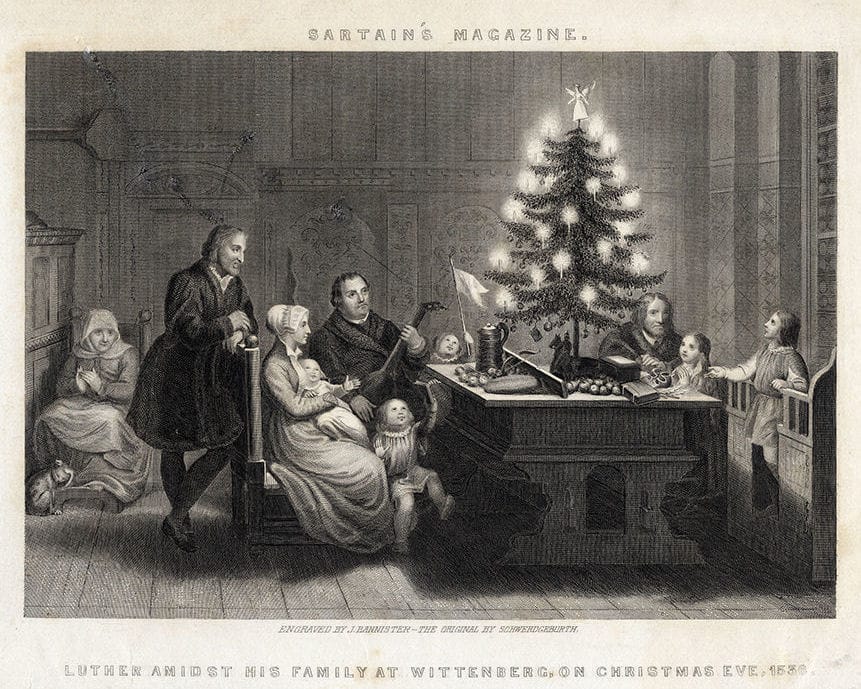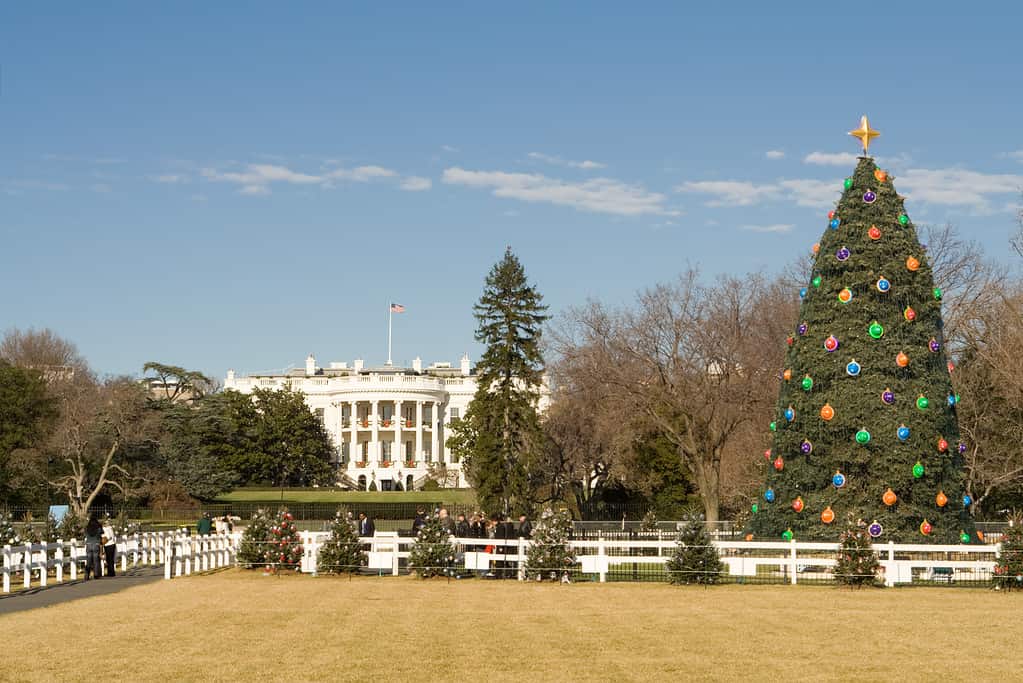The Christmas tree is one of the most iconic symbols for the Christmas holidays. For those who celebrate the holiday each December, they make sure they have Christmas lights on the roofs and outside walls of their house. People decorate their homes with Christmas trinkets like elves, reindeer, Santa Claus, and even a manger. But the most important part is the Christmas tree, always on display as the centerpiece in the living room. Families decorate the Christmas tree with tinsel, colorful lights, ornaments, and a golden star on top. Presents are left underneath the tree and opened on Christmas Eve or Christmas Day.
But most people don’t know the history of how the Christmas tree came about. What is the symbolism and meaning behind the Christmas tree? Let’s find out. We’ll explore all those questions and more.
Symbolism and Meanings

Around 35 million Christmas trees are produced in the US and around 50-60 million in Europe every year.
©Sonia Horowitz/Shutterstock.com
There are several meanings of the Christmas tree and it all depends on where you come from. The religious significance of the Christmas tree is that the tree signifies a symbol of God, that its leaves are evergreen and will never die whose needles on the tree point to heaven. The lights on the tree symbolize that Jesus Christ is the light of the world. The star that is put as a tree topper signifies the Star of Bethlehem. It is also popular to put an angel on top instead, which signifies the story of Jesus’s birth.
But of course, different cultures have their meanings to what the Christmas tree signifies. For example, the Romans had evergreen trees throughout their homes to celebrate the festival of Saturnalia, held each year on December 17 to celebrate the god Saturn. Vikings and Scandinavians used to worship trees and they would put evergreen trees in their houses and barns to ward off the devil. This tradition of putting up evergreen trees to scare away evil spirits and “devil-like creatures” has been seen in many cultures.
The Druids believed trees were a gift from Mother Earth. They would decorate oak trees, which were considered sacred, to represent life. Likewise, there were traditions amongst the Chinese and the ancient Egyptians where they would put evergreen garlands, wreaths, or trees to signify eternal life. Lastly, Germans believed that if they put trees in the house during winter, it would bring them good luck with their crops.
The Myth of Saint Boniface
Perhaps one of the most popular myths about the Christmas tree revolves around Saint Boniface. In the 8th century, there was about to be a human sacrifice under an oak tree, as was pagan tradition. He dashed to the rescue of the poor person about to be murdered and instead cut down the oak tree. Over time, a fir tree grew where the oak tree used to be. The triangular tree represented the Holy Trinity and the branches signified Jesus Christ’s eternal life and truth.
History of the Christmas Tree

In 1844, Hans Christian Andersen wrote a fairy tale called
The Fir-Treeabout a fir tree used as a Christmas tree.
Although there have been reports of earlier traditions of trees being put in homes, it is said that the modern Christmas tree traditions started in Central or Northern Europe — mainly Germany, Estonia, and Latvia. During the Middle Ages, the Cistercian Alcobaça Monastery in Portugal put up a Christmas tree. Likewise, there have been rumors that Martin Luther was the first to put candles on an evergreen tree, but the monastery’s records mention candles on oranges that were hung on their tree.
Decorated trees can be traced back to the 1400s in Estonia and Latvia with a tree put up in town squares. Furthermore, in Bremen in 1570, people would decorate trees with apples, nuts, and paper flowers. In Poland, they would put branches or wreaths on ceilings for the traditional Slavic festival Koliada.
Over time, the tradition and custom of putting up a Christmas tree spread to the rest of Europe. It was popularized in England during Queen Victoria’s reign. In North America, it spread throughout the 1700s and 1800s.
Present-Day Traditions
Today, putting up the Christmas tree is a family tradition. The ornaments we put up have a different meaning for each family. Sometimes, there is a theme attached to their Christmas trees. Sometimes, families love to color-code them. Some families individualize their trees by putting up ornaments that symbolize the family members or their favorite hobbies and things.
As each day of the Christmas season passes, presents are put under the tree. Children await with enthusiasm to open them. Finally, when it comes to Christmas Eve or Christmas Day, each member of the family opens the wrapped presents. Children are screaming with joy at their new toys. Everyone is happy, surrounded by family and the Christmas tree in full regalia.
What Kinds of Trees Do People Use?
The Christmas tradition of having a tree display in a home also means picking out the right kind of tree. Of course, we’ve all been to someone’s house and there is a decorated Christmas cactus atop a living room table. Also, we’ve been to cities in warmer climates and they have palm trees decorated with lights. But what does the tradition say about the kinds of trees used for Christmas trees?
Typically, people use firs, spruces, and pines as Christmas trees. Here are some of the most popular trees.
- Norway spruce (Picea abies)
- Silver fir (Abies alba)
- Noble fir (Abies procera)
- Douglas fir (Pseudotsuga menziesii)
- Grand fir (Abies procera)
- Balsam fir (Abies balsamea)
Famous Christmas Trees Around the World

President Benjamin Harrison and his wife, Caroline, were the first to put up the Christmas tree in the White House. Since then, it has been a tradition with every president.
©jim pruitt/iStock via Getty Images
For those who celebrate, there are people throughout the world who put up their Christmas trees in their homes. However, towns and cities also participate in that venture. Here are some of the most famous Christmas trees around the world. Maybe you’ll recognize some.
Rockefeller Center Christmas Tree
Every year, the Rockefeller Center has a huge Norway spruce Christmas tree on display from late November until mid-January. The tradition started in 1931 and now over 125 million people go see the display each year. Furthermore, millions of viewers watch the televised tree lighting.
Gubbio, Italy Christmas Tree
Every year, the town puts giant Christmas lights in the shape of a Christmas tree on the slopes of Mount Ingino in Gubbio, Italy. Residents can see it from anywhere in the town, which is awesome to look at.
Puerta del Sol Christmas Tree
Madrid’s regal and giant Christmas tree isn’t the only thing in the square that is lit with colorful Christmas lights. There is also a Christmas market nearby in Plaza Mayor, as well as lighting displays on every street.
If you are traveling around and want to check out some great Christmas tree displays, here are some other notable mentions:
- Zócalo, Mexico City Christmas Tree
- Trafalgar Square, London Christmas Tree
- Strasbourg, France Christmas Tree
- Capitol Hill, Washington D.C. Christmas Tree
- Vilnius, Lithuania Christmas Tree
Conclusion
And there you have it, that’s the symbolism and meaning behind the Christmas tree. Those traditions started in Central Europe during the Middle Ages. From there, it is rumored that Martin Luther added lit candles to the tree, and from there it took off to the traditions and customs we have today. The Christmas tree is now the centerpiece of every home of those families that celebrate Christmas. Today, the Christmas tree has far more meaning than just a religious significance. Families gather around it and celebrate what Christmas means to them — happiness and joy, selflessness, gratitude, unity, peace, and family.
The photo featured at the top of this post is © Christian Carollo/Shutterstock.com
Thank you for reading! Have some feedback for us? Contact the AZ Animals editorial team.







